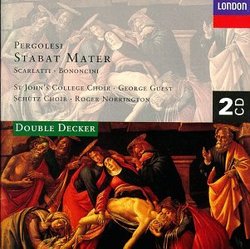| All Artists: Giovanni Pergolesi, Domenico Scarlatti, Alessandro Scarlatti, Antonio Lotti, George Guest, David Willcocks, Christopher Wellington, Argo Chamber Orchestra, Academy of St. Martin-in-the-Fields, London Philomusica, David Hill, Charles Spinks, John Scott, Elizabeth Vaughan, Ian Partridge, Felicity Palmer, Paul Esswood, Philip Langridge Title: Stabat Mater: Pergolesi; Scarlatti... Members Wishing: 0 Total Copies: 0 Label: Decca Release Date: 2/13/1996 Genres: Special Interest, Pop, Classical Styles: Vocal Pop, Opera & Classical Vocal, Historical Periods, Baroque (c.1600-1750) Number of Discs: 2 SwapaCD Credits: 2 UPC: 028944386820 |
Search - Giovanni Pergolesi, Domenico Scarlatti, Alessandro Scarlatti :: Stabat Mater: Pergolesi; Scarlatti...
 | Giovanni Pergolesi, Domenico Scarlatti, Alessandro Scarlatti Stabat Mater: Pergolesi; Scarlatti... Genres: Special Interest, Pop, Classical
|
Larger Image |
CD Details |
CD ReviewsA voice teacher and early music fan George Peabody | Planet Earth | 01/19/2007 (5 out of 5 stars) "AN EARLY MUSIC BONANZA!
The 'Stabat Mater' is a medieval poem describing the anguish of the Virgin Mary during the crucifixion written at the end of the 13th century by a Franciscan lay brother named Jacopone da Todi. It did not attract widespread attention from composers until the 18th century when Alessandro Scarlatti,his son Domenico, Vivaldi, Bononcini, Haydn and Pergolesi as well as many others set the poem to music. They were, no doubt, attracted to the emotional and dramatic nature of the poem, and most of the composers were commissioned by various individuals for non-liturgical devotions or concerts. Alessandro Scarlatti's seems to be the earliest of the group. He scored it for soprano and alto voices(probably sung by a 'castrati' at that time), two violins and continuo. This setting was used frequently until Pergolesi's setting around 1735. Pergolesi modeled his composition after Scarlatti; for one thing both are scored for the same 2 voices and strings. Both divide the poem into a number of duets and solo arias. One difference between the two settings is that Pergolesi's is shorter and rather more concise. It is not certain that Pergolesi actually wrote the 'Magnificat' on this disc, but it is a quality and richly imaginative work, nonetheless. Domenico's 'Stabat Mater' is set for 10 voices and organ and its mood is meditative clearly intended for liturgical use. Bononcini's 'Stabat Mater' was composed during his residence in Vienna. It is unique because of its harmonic and contrapuntal writing, in the choruses in particular and in the soprano aria 'O Quam Tristis'. It could have been written by Bach himself. The two 'Crucifixus' settings by Lotti and Caldara are both examples of the old-style composition as it had developed by the late Baroque; the harmonic and expressive techlniques of the new style were applied to the old polyphony, providing a highly emotional vehicle for a creative composer. Opera and cantata were the 2 principal forms which Alessandro Scarlatti practised, but he also composed some superb motets, two of which are featured on this disc. 'O Magnum Mysterium' is for double choir eight-part counterpoint. 'Domine refugium factus es nobis' is for five voices; it is in a style that relies much on sonorous harmony and counterpoint; in fact it has a grandeur that anticipates Handel. I think that it is interesting to note that there are varied groups and soloists performing on these disc, and all are quite good. Pergolesi's 'Stabat Mater' is disappointing to me because it does not have a countertenor performing the alto part; it is really not authentic since at that time either 'castrati' or male altos did so. ON disc 2, there is a countertenor performing in the correct capacity, and I obviously prefer that disc. But all renditions are done skillfully, and you certainly have a lot of beautiful music included therein." |

 Track Listings (19) - Disc #1
Track Listings (19) - Disc #1